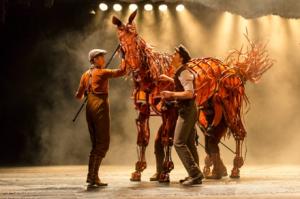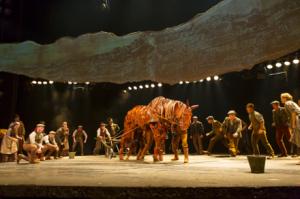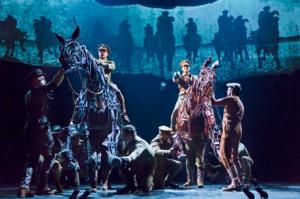By Nancy Brannon, Ph.D.
Many Mid-South Horse Review readers were treated to the premier showing of War Horse the movie in Memphis, TN a few years ago and many may have read Leigh Ballard’s review of Michael Morpurgo’s book War Horse in the December 2011 issue. The stage adaptation of the book by the National Theater of Great Britain, which played on Broadway in New York through January 6, is on tour throughout the U.S. In March it will be coming to the BJCC Concert Hall in Birmingham, AL and the Orpheum Theater in Memphis, TN; in June, to the Tennessee Performing Arts Center in Nashville, TN.
The stage production uses extraordinary, life-sized (or larger) puppet horses to bring the story to life on stage. The story follows the journeys through World War I of Joey, a Devonshire horse, and his young master, Albert. Joey is a rare equine survivor of the brutality of war, with cavalry charges, barbed wire, machine-gun fire, lethal gases, and pulling heavy guns through mud and muck. The genius behind the puppetry is South Africa’s Handspring Puppet Company. They created the puppets, who appear as breathing, galloping, charging horses brought to life. Public Television, WKNO TV, broadcast “The Making of War Horse” last year, which explains in detail how the puppets are brought to life on stage.
Jon Riddelberger is the head puppeteer in War Horse, alternately “operating” Joey and Topthorn, the sleek black horse that Joey meets when he first ends up in the British Cavalry. I interviewed Riddleberger about his experiences operating the puppets in the stage production.
I first asked him how discerning horse people might perceived the puppets. “The gestures of the horses are very horse-like, not mechanical,” he explained. He is well aware that horse people notice these things, so I asked him how he learned his task and how he operates the puppets.
“Each horse has three [puppeteer] positions: the heard, heart, and hind.” As head puppeteer, Jon operates the head, neck and ears. The heart puppeteer operates the front two legs and the breast, creating the breathing movements. The hind puppeteer operates the back two legs and tail.
“It’s really cool about what we do,” he commented. “Each gives some practical movement to the horse. We make sure the footfalls are correct and that the head is held in the correct position. Control of the ears is very important because this is a big emotional indicator of the horse. We all have different responsibilities, and our goal is to create one complete character with individual thoughts. It’s a super exciting task!”
Although Jon had not had much personal experience with horses, he has learned a tremendous amount about horses and their movements. “I rode a horse once in the 6th grade on a church trip,” he said, and at the end of high school I worked on a draft horse farm. But I never spent much time with horses.”
Before the start of the show, the puppeteers had two intense weeks of horse camp, where they interacted with horse and learned about how the puppets operate. “Then the rest of the cast joined us at rehearsals. We took what we had learned and put it to the story of the play,” he explained. “It’s still an evolving process. We observe horses and pick up on their behaviors. Horses have individual personalities and there’s a lot to learn.”
The puppets are really larger than life. Jon explained: “Joey is a hunter, half Thoroughbred and half draft. The puppet weighs about 120 pounds. Topthorn, a Thoroughbred, is bigger than Joey and weighs about 150 pounds. When I’m operating the head, sometimes I have to get on my tiptoes to make the gestures.”
Jon has done some other work in New York City theaters, but this is the biggest scale puppetry he’s ever done. He’s been with War Horse since the start of the tour and he’s been on the road a long time, since May 2012. It’s a grueling schedule. “We perform 6 days a week, 8 shows per week. We travel on Monday and perform Tuesday through Saturday. Jon says he does, however, miss having a home, being on the road for so long.
Some of the cast in the play are actors only, some are dancers, and some are puppeteers. “These puppets use every bit of training I’ve had to make it work, “Jon said. But the show doesn’t get boring. When you have a team of three operating a puppet, it gives a natural spontaneity to the production. My two teammates consistently surprise me!” Jon said. “We have to listen to each other and engage each other.”
Jon continued, “One of the reasons the story is so effective is that Joey is in the center of human drama. Joey becomes a moral compass. The horses reflect the people around them. Horses make you confront yourself. Joey erases the lines of nationality. It’s not about who’s English or French, etc., but about who is a trust worthy person. Who is good and who is bad. Everyone is in a tough predicament. Joey shows the pointlessness of war. Using the horse to tell the story, author Michael Morpurgo hit on something very profound!”
For more information about War Horse On Stage and U.S. tour dates, visit: www.warhorseonstage.com
If you missed it on Public Television, The Making of War Horse is available on YouTube: http://www.youtube.com/watch?v=_gCBnA4e2VM .
(All photos are @Brinkhoff/Mögenburg)
Many Mid-South Horse Review readers were treated to the premier showing of War Horse the movie in Memphis, TN a few years ago and many may have read Leigh Ballard’s review of Michael Morpurgo’s book War Horse in the December 2011 issue. The stage adaptation of the book by the National Theater of Great Britain, which played on Broadway in New York through January 6, is on tour throughout the U.S. In March it will be coming to the BJCC Concert Hall in Birmingham, AL and the Orpheum Theater in Memphis, TN; in June, to the Tennessee Performing Arts Center in Nashville, TN.
The stage production uses extraordinary, life-sized (or larger) puppet horses to bring the story to life on stage. The story follows the journeys through World War I of Joey, a Devonshire horse, and his young master, Albert. Joey is a rare equine survivor of the brutality of war, with cavalry charges, barbed wire, machine-gun fire, lethal gases, and pulling heavy guns through mud and muck. The genius behind the puppetry is South Africa’s Handspring Puppet Company. They created the puppets, who appear as breathing, galloping, charging horses brought to life. Public Television, WKNO TV, broadcast “The Making of War Horse” last year, which explains in detail how the puppets are brought to life on stage.
Jon Riddelberger is the head puppeteer in War Horse, alternately “operating” Joey and Topthorn, the sleek black horse that Joey meets when he first ends up in the British Cavalry. I interviewed Riddleberger about his experiences operating the puppets in the stage production.
I first asked him how discerning horse people might perceived the puppets. “The gestures of the horses are very horse-like, not mechanical,” he explained. He is well aware that horse people notice these things, so I asked him how he learned his task and how he operates the puppets.
“Each horse has three [puppeteer] positions: the heard, heart, and hind.” As head puppeteer, Jon operates the head, neck and ears. The heart puppeteer operates the front two legs and the breast, creating the breathing movements. The hind puppeteer operates the back two legs and tail.
“It’s really cool about what we do,” he commented. “Each gives some practical movement to the horse. We make sure the footfalls are correct and that the head is held in the correct position. Control of the ears is very important because this is a big emotional indicator of the horse. We all have different responsibilities, and our goal is to create one complete character with individual thoughts. It’s a super exciting task!”
Although Jon had not had much personal experience with horses, he has learned a tremendous amount about horses and their movements. “I rode a horse once in the 6th grade on a church trip,” he said, and at the end of high school I worked on a draft horse farm. But I never spent much time with horses.”
Before the start of the show, the puppeteers had two intense weeks of horse camp, where they interacted with horse and learned about how the puppets operate. “Then the rest of the cast joined us at rehearsals. We took what we had learned and put it to the story of the play,” he explained. “It’s still an evolving process. We observe horses and pick up on their behaviors. Horses have individual personalities and there’s a lot to learn.”
The puppets are really larger than life. Jon explained: “Joey is a hunter, half Thoroughbred and half draft. The puppet weighs about 120 pounds. Topthorn, a Thoroughbred, is bigger than Joey and weighs about 150 pounds. When I’m operating the head, sometimes I have to get on my tiptoes to make the gestures.”
Jon has done some other work in New York City theaters, but this is the biggest scale puppetry he’s ever done. He’s been with War Horse since the start of the tour and he’s been on the road a long time, since May 2012. It’s a grueling schedule. “We perform 6 days a week, 8 shows per week. We travel on Monday and perform Tuesday through Saturday. Jon says he does, however, miss having a home, being on the road for so long.
Some of the cast in the play are actors only, some are dancers, and some are puppeteers. “These puppets use every bit of training I’ve had to make it work, “Jon said. But the show doesn’t get boring. When you have a team of three operating a puppet, it gives a natural spontaneity to the production. My two teammates consistently surprise me!” Jon said. “We have to listen to each other and engage each other.”
Jon continued, “One of the reasons the story is so effective is that Joey is in the center of human drama. Joey becomes a moral compass. The horses reflect the people around them. Horses make you confront yourself. Joey erases the lines of nationality. It’s not about who’s English or French, etc., but about who is a trust worthy person. Who is good and who is bad. Everyone is in a tough predicament. Joey shows the pointlessness of war. Using the horse to tell the story, author Michael Morpurgo hit on something very profound!”
For more information about War Horse On Stage and U.S. tour dates, visit: www.warhorseonstage.com
If you missed it on Public Television, The Making of War Horse is available on YouTube: http://www.youtube.com/watch?v=_gCBnA4e2VM .
(All photos are @Brinkhoff/Mögenburg)












